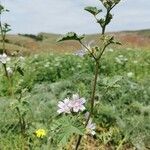Annual, procumbent to erect herb. Stems sparsely to moderately hairy with mostly stellate hairs. Lvs sparsely to densely clothed in mostly stellate hairs above, moderately clothed in mostly stellate hairs below, reniform to orbicular, cordate, shallowly or moderately 5-7-palmately lobed and crenate, 1-8 cm diam.; petioles 1.5-10 cm long; stipules ovate-triangular, 2-6 mm long. Fls in axillary clusters of (1)-2-5; fruiting pedicels 2-10-(20) mm long; epicalyx segments linear, somewhat < calyx; calyx teeth ± orbicular with acute apex, glabrous or sparsely clothed in stellate hairs and ciliate, greatly enlarged and spreading at fruiting; petals white, pale mauve or pink towards tips, ± = or only slightly > calyx, 3-5 mm long. Mericarps (9)-10-(11) per fr., glabrous or hairy, strongly reticulately veined on back; edges slightly winged and sometimes toothed.
Prostrate or decumbent herb; stems usually under 40 cm long, hairy, longitudinally sulcate. Leaf-lamina 1-5 x 1-5 cm, reniform or nearly suborbicular in outline, obtusely 3-5-angled, crenate or crenate-serrate, glabrous or sparsely hairy; petiole often longer than the lamina, usually with a few hairs near the apex. Flowers mauve or pale pink to white, subsessile, in few-flowered clusters in the leaf-axils; pedicels 2-4 mm long. Bracts of epicalyx linear, deciduous. Calyx 2-5 mm long, accrescent and enclosing the fruit; lobes ovate or roundish, mucronate, spreading. Petals scarcely exceeding the calyx; claw glabrous. Fruit glabrous or occasionally hairy; mericarps with acutely-angled reticular dorsal ridges and slightly raised and sharp lateral angles.
Prostrate or decumbent, perennial herb, stems 0.15-0.40 m long; taproots deep, strong. Leaves reniform, distinctly (3)5(7)-lobed, margins dentate. Flowers in small, axillary clusters, white or pale lilac. Epicalyx of 3 free bracts, free to base, linear-lanceolate. Flowering time Oct.-Jan. Fruit flattened, discoid schizocarps, surrounded by enlarged calyces. Mericarps 9-11, 1-seeded, glabrous, rugose; edges of mature mericarps slightly raised, often toothed and somewhat overlapping adjoining mericarps. Seeds reniform, dark brown, minutely tuberculate.
An erect annual herb. It grows up to 50-100 cm high. The leaves are rounded but heart shaped at the base. They are 2-6 cm across. They have shallow lobes and a wavy edge. There are fine teeth around the edge. The flowers are pink or white. They are about 5 mm across. They are clustered near the base of the leaves. The fruit or nutlets are brown when ripe and the backs are wavy.
Much like nos. 5 [Malva neglecta Wallr.] and 6 [Hypericum boreale (Britton) E. P. Bicknell]; pedicels mostly less than 10 mm, even in fr; cal strongly accrescent and reticulate-veiny in fr; fr as in no. 6, but the margins of the carpels narrowly winged; 2n=42. Native of the Mediterranean region, widespread as a weed in c. and w. U.S., and local with us.
Prostrate or decumbent herb, up to 400 mm tall. Leaves long-petiolate, blades reniform to suborbicular, round-toothed. Flowers clustered in leaf axils, pale pink to white, petals scarcely longer than calyx, epicalyx of 6 mmear lobes.
Prostrate or decumbent herb. Petals scarcely exceeding calyx, with glabrous claws. Mericarps with acutely angled reticular dorsal ridges, meeting laterally in somewhat raised sharp edge. Flowers mauve or pale pink to white.












